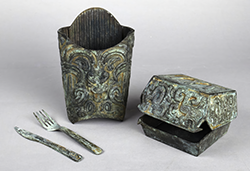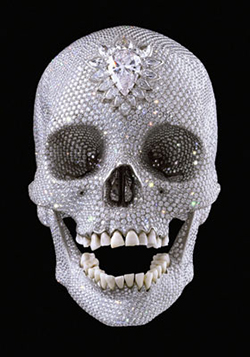MENU
The Electronic Scholarly Publishing Project: Providing access to classic scientific papers and other scholarly materials, since 1993. More About: ESP | OUR CONTENT | THIS WEBSITE | WHAT'S NEW | WHAT'S HOT
Comparative Timelines
The ESP Timeline (one of the site's most popular features) has been completely updated to allow the user to select (using the timeline controls above each column) different topics for the left and right sides of the display.
Select:
New Left Column
New Left Column
Dates
Decade
New Right Column
New Right Column
Based on studies of Y chromosomes, Peter Underhill publishes his finding that all modern humans share a common ancestor, bolstering the 1987 announcement from Cann and Wilson. This suggests a "bottleneck" event (population crash) among human ancestors living in Africa roughly 150,000 years ago.
Sally McBearty and Alison Brooks publish "The Revolution that Wasn't" challenging the long-held notion of a "big bang" in human intellectual evolution approximately 40,000 years ago. Instead, they cite evidence for earlier appearances of modern behavior.
2000
(no entry for this year)
(no entry for this year)
2001
(no entry for this year)
(no entry for this year)
2002
 Sculpture by Zhang Hongtu: Mai Dang Lao (McDonald's), a set of readily identifiable McDonald's hamburger box, french-fry container, fork, and knife are cast in bronze and adorned with traditional Chinese designs. The artist has transformed ubiquitous consumer items into what at first glance appear to be Shang dynasty artifacts. Hilarious.
Sculpture by Zhang Hongtu: Mai Dang Lao (McDonald's), a set of readily identifiable McDonald's hamburger box, french-fry container, fork, and knife are cast in bronze and adorned with traditional Chinese designs. The artist has transformed ubiquitous consumer items into what at first glance appear to be Shang dynasty artifacts. Hilarious.
(no entry for this year)
2003
(no entry for this year)
Peter Brown, Mike Morwood and collaborators announce the find of a 1-meter- tall hominid skeleton on the Indonesian island of Flores. Found near the remains of giant lizards and pygmy elephants, the new species is formally named Homo floresiensis and nicknamed the "hobbit." Though some suspect it's a kind of malformed, small-brained midget, this interpretation will be answered by braincase scans, wrist bones too primitive to be Homo sapiens, and the announcement of several more individuals of the same species. Later studies will suggest direct ancestry from Homo erectus, although another study will argue the remains really indicate Down syndrome. The species is initially given an estimated age as young as 11,000 years, but later research will indicate an age of at least 50,000 years.
2004
(no entry for this year)
(no entry for this year)
2005
(no entry for this year)
Jean Moliner, Gerhard Ries, Cyril Zipfel and Barbara Hohn publish their findings on stressed plants that not only mutate at a greater rate, but also pass an increased mutation tendency to their offspring.
2006
(no entry for this year)
(no entry for this year)
2007
 Sculpture by Damien Hirst: For the Love of God consists of a platinum cast of an 18th-century human skull encrusted with 8,601 flawless diamonds, including a pear-shaped pink diamond located in the forehead that is known as the Skull Star Diamond. The skull's teeth are actual human teeth, and were purchased by Hirst in London. The artwork is a Memento mori, or reminder of the mortality of the viewer. In 2007, art historian Rudi Fuchs, observed: 'The skull is out of this world, celestial almost. It proclaims victory over decay. At the same time it represents death as something infinitely more relentless. Compared to the tearful sadness of a vanitas scene, the diamond skull is glory itself.' Costing 14 million to produce, the work was placed on its inaugural display at the White Cube gallery in London in an exhibition Beyond belief with an asking price of 50 million. This would have been the highest price ever paid for a single work by a living artist. The base for the work is a human skull bought in a shop in Islington. It is thought to be that of a 35-year-old European who lived between 1720 and 1810. The work's title was supposedly inspired by Hirst's mother, who once asked, "For the love of God, what are you going to do next? Hirst said that the work was sold on 30 August 2007, for 50 million, to an anonymous consortium. Christina Ruiz, editor of The Art Newspaper, claims that Hirst had failed to find a buyer and had been trying to offload the skull for 38 million. Immediately after these allegations were made, Hirst claimed he had sold it for the full asking price, in cash, leaving no paper trail. The consortium that bought the piece included Hirst himself.
Sculpture by Damien Hirst: For the Love of God consists of a platinum cast of an 18th-century human skull encrusted with 8,601 flawless diamonds, including a pear-shaped pink diamond located in the forehead that is known as the Skull Star Diamond. The skull's teeth are actual human teeth, and were purchased by Hirst in London. The artwork is a Memento mori, or reminder of the mortality of the viewer. In 2007, art historian Rudi Fuchs, observed: 'The skull is out of this world, celestial almost. It proclaims victory over decay. At the same time it represents death as something infinitely more relentless. Compared to the tearful sadness of a vanitas scene, the diamond skull is glory itself.' Costing 14 million to produce, the work was placed on its inaugural display at the White Cube gallery in London in an exhibition Beyond belief with an asking price of 50 million. This would have been the highest price ever paid for a single work by a living artist. The base for the work is a human skull bought in a shop in Islington. It is thought to be that of a 35-year-old European who lived between 1720 and 1810. The work's title was supposedly inspired by Hirst's mother, who once asked, "For the love of God, what are you going to do next? Hirst said that the work was sold on 30 August 2007, for 50 million, to an anonymous consortium. Christina Ruiz, editor of The Art Newspaper, claims that Hirst had failed to find a buyer and had been trying to offload the skull for 38 million. Immediately after these allegations were made, Hirst claimed he had sold it for the full asking price, in cash, leaving no paper trail. The consortium that bought the piece included Hirst himself.
After studying grunting fish, Andrew Bass and colleagues report that the part of the brain controlling volcalization is extremely primitive, and propose that vertebrates evolved the ability to communicate through sound some 400 million years ago.
2008
(no entry for this year)
Gabriele Gentile and colleagues describe a previously overlooked pink iguana, referred to as "rosada," on the Galápagos Islands. The pink lizard species may represent the earliest divergence of land animals on the island chain that Charles Darwin made famous.
2009
(no entry for this year)
ESP Quick Facts
ESP Origins
In the early 1990's, Robert Robbins was a faculty member at Johns Hopkins, where he directed the informatics core of GDB — the human gene-mapping database of the international human genome project. To share papers with colleagues around the world, he set up a small paper-sharing section on his personal web page. This small project evolved into The Electronic Scholarly Publishing Project.
ESP Support
In 1995, Robbins became the VP/IT of the Fred Hutchinson Cancer Research Center in Seattle, WA. Soon after arriving in Seattle, Robbins secured funding, through the ELSI component of the US Human Genome Project, to create the original ESP.ORG web site, with the formal goal of providing free, world-wide access to the literature of classical genetics.
ESP Rationale
Although the methods of molecular biology can seem almost magical to the uninitiated, the original techniques of classical genetics are readily appreciated by one and all: cross individuals that differ in some inherited trait, collect all of the progeny, score their attributes, and propose mechanisms to explain the patterns of inheritance observed.
ESP Goal
In reading the early works of classical genetics, one is drawn, almost inexorably, into ever more complex models, until molecular explanations begin to seem both necessary and natural. At that point, the tools for understanding genome research are at hand. Assisting readers reach this point was the original goal of The Electronic Scholarly Publishing Project.
ESP Usage
Usage of the site grew rapidly and has remained high. Faculty began to use the site for their assigned readings. Other on-line publishers, ranging from The New York Times to Nature referenced ESP materials in their own publications. Nobel laureates (e.g., Joshua Lederberg) regularly used the site and even wrote to suggest changes and improvements.
ESP Content
When the site began, no journals were making their early content available in digital format. As a result, ESP was obliged to digitize classic literature before it could be made available. For many important papers — such as Mendel's original paper or the first genetic map — ESP had to produce entirely new typeset versions of the works, if they were to be available in a high-quality format.
ESP Help
Early support from the DOE component of the Human Genome Project was critically important for getting the ESP project on a firm foundation. Since that funding ended (nearly 20 years ago), the project has been operated as a purely volunteer effort. Anyone wishing to assist in these efforts should send an email to Robbins.
ESP Plans
With the development of methods for adding typeset side notes to PDF files, the ESP project now plans to add annotated versions of some classical papers to its holdings. We also plan to add new reference and pedagogical material. We have already started providing regularly updated, comprehensive bibliographies to the ESP.ORG site.
ESP Picks from Around the Web (updated 06 MAR 2017 )
Old Science

Weird Science

Treating Disease with Fecal Transplantation
Fossils of miniature humans (hobbits) discovered in Indonesia

Dinosaur tail, complete with feathers, found preserved in amber.
Astronomy

Mysterious fast radio burst (FRB) detected in the distant universe.